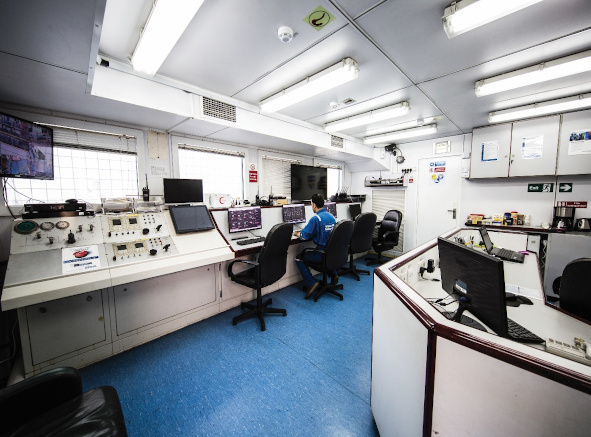DESCRIPTION
Production Services Platform (PSP):
Corrosion Tests of different corrosive fluids with production liner, tubing, coiled Tubing.
From the measured data our experts develop below information:
- Locating sources of undesired fluid phase production such as water entries
- Isolating mechanical problems such as leaking pipes, leaking packers, and fluid movement in cement channels behind pipe
- Evaluating the effectiveness of well treatment or workover operations by comparing the before and after job surveys
- In EOR projects, maintaining injection efficiency by evaluating the injection profiles of individual wells in a field
Our experts design the PSP jobs according to client objectives and well data. The logs are monitored during the job real time and the design changed if it is needed to acquire more information about production/injection profile and well mechanical problems. After finishing the job, the data processed and interpreted by our experts and the results presented and reported for client.
Formation pressure testing:
From the measured data our experts develop information on formation fluid type, fluid density, fluid contact depths, and formation connectivity. Together with recovered fluid samples, these data provide crucial exploration and development information for oil and gas fields. Our experts design the Formation Pressure Testing jobs according to client objectives and Petrophysical data. The measured data are monitored during the job real time and the design changed if it is needed. After finishing the job, the data processed and interpreted by our experts and the results presented and reported for client.
Fluid Sampling/Profiling/downhole fluid analysis:
Fluid Sampling/Profiling/downhole fluid analysis performed during formation pressure testing. DCS engineer monitors the formation pressure testing results real time and proposes the proper points for fluid profiling. The formation fluid type determined during fluid profiling. DCS engineer monitors live fluid analysis data and suggests the best points to collect formation fluid.
Stress testing/Mini-frac:
Before job, DCS engineers analyzed available Image log and Petrophysics data and propose intervals to be conducted under stress testing. After finishing the job, the data processed and interpreted by DCS experts and the results presented and reported for client.
Well testing:
Job design, data processing and interpretation
In WSI the Well testing job designed according to client objectives and available well and reservoir data. The pressure results are monitored during the job real time (in the case of surface well testing jobs) and the design changed if it is needed to acquire more information about well, reservoir and boundary models. After finishing the job, the data processed and interpreted by our experts and the results presented and reported for client.
Noise log:
Job design, data processing and interpretation
In WSI the Noise log designed according to client objectives and available well data. After finishing the job, the data processed and interpreted by our experts and the results (leaks detection, locating any cross flows and flows behind casing, identification of production and injection intervals) presented and reported for client.
Fullsuite log analysis
In our conventional fullsuite, the saturation profile, effective and total porosity, lithology curves will be our products. Advanced full suite interpretation like integrating core evaluation, rock typing and permeability prediction will be done as per client request.
CMR interpretation
CMR is an advanced tool for determination of pore size distribution, permeability analysis, free fluid, bond fluid and capillary fluid porosity. The T2 decay is further processed to give the total pore volume (the total porosity) and pore volumes within different ranges of T2. The most common volumes are the bound fluid and free fluid.
In advanced interpretation, Pore size analysis, pseudo-capillary analysis, viscosity transform, T2 cut off analysis can be done, which help our client to decide where to perforate and water cut analysis and fluid typing.
DSI interpretation
Compressional, shear and stoneley slownesses will be our very first products, which then will result in, the flexural wave analysis of the altered zone, as well as to formation anisotropy, whether intrinsic or stress-induced, fracture evaluation and stoneley permeability will be our final product
These products are also used in geomechanical study for Mechanical Earth Modeling and etc.
Cement Evaluation
Cement evaluation plays an important role for future of a well. Our experts will analyze, USIT and CBL-VDL to help our clients whether to squeeze cement or any remedial operation will be needed.
A log that uses the variations in amplitude of an acoustic signal traveling down the casing wall between a transmitter and receiver to determine the quality of cement bond on the exterior casing wall. The fundamental principle is that the acoustic signal will be more attenuated in the presence of cement than if the casing were uncemented. The measurement is largely qualitative, as there is no indication of azimuthal cement variations such as channeling, and as it is sensitive to the effect of a microannulus.
Borehole Geology
FMI, with 80% borehole coverage in 8-in boreholes and 0.2-in image resolution in the vertical and azimuthal directions, imaging with the FMI microimager is the preferred approach for determining net pay in laminated sediments of fluvial, turbidite and carbonate depositional environments.
Knowledge of sedimentary features is important for determining reservoir geometry and petrophysical reservoir parameters. Image details can be discerned down to 50 um and complement coring and sampling data, especially for describing intervals that were not cored. Interpretation that combines images and derived sedimentary dip data from the FMI microimager gives you greater insight into structures—both natural and drilling induced—that are present in the reservoir. Beyond the wellsite answers listed for basic structural and sedimentary understanding, integrated interpretation employs advanced workflows, the multidisciplinary expertise of our interpretation geoscientists and engineers working on the application of software to maximize the value of client logging data. The result is the fullest possible understanding of structural and stratigraphic features, including complex faults, folds, porosity distributions, and net sand counts.






